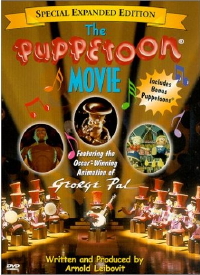The Puppetoon Movie facts for kids
Quick facts for kids The Puppetoon Movie |
|
|---|---|

DVD Cover
|
|
| Directed by | Arnold Leibovit |
| Produced by | Arnold Leibovit |
| Written by | Arnold Leibovit |
| Starring | voices of
|
| Music by | Buddy Baker |
| Studio | Arnold Leibovit Entertainment |
| Distributed by | Expanded Entertainment |
| Release date(s) | June 12, 1987 |
| Running time | 90 minutes |
| Country | United States |
| Language | English |
The Puppetoon Movie is an animated film from 1987. It was written, produced, and directed by Arnold Leibovit. The movie is based on the famous Puppetoons characters. These characters were created by George Pal in the 1930s and 1940s.
The film uses a special type of animation called Puppetoon animation. It features well-known characters like Gumby and Pokey. A dinosaur named Arnie also joins them. These characters host the main story that connects all the shorter films. The voices of Dick Beals, Art Clokey, Paul Frees, and Dal McKennon bring the main characters to life.
When it first came out in 1987, The Puppetoon Movie included 11 original Puppetoons. Later, more shorts were added. The 2000 DVD version had 9 extra Puppetoons. The 2013 Blu-ray release added 7 more. In 2020, The Puppetoon Movie Volume 2 came out. It featured 17 new shorts that were not in the earlier movies.
Contents
What Happens in the Movie
The film begins on a movie set. Gumby and his friends are making a dinosaur film. A big Tyrannosaurus rex named Arnie is supposed to be scary. He is about to eat a young deer named Barbara. But Arnie takes out his fake teeth. He lets the deer go because he feels sorry for her.
Gumby is the director and stops the scene. He asks Arnie why he didn't act mean. Arnie knows it is just acting. But he feels he is not right for the part. He explains that he used to be fierce. However, thanks to George Pal, he changed. Now, Arnie is a vegetarian and very kind.
Gumby does not understand how George Pal changed Arnie so much. So, Arnie and Pokey decide to show Gumby some of George Pal's short films. This helps Gumby understand how important the artist is. This is how The Puppetoon Movie begins.
Featured Short Films
Many of George Pal's short films are shown in the movie. These include:
- The Little Broadcast
- Philips Broadcast of 1938
- Hoola Boola
- South Sea Sweethearts
- The Sleeping Beauty
- Tulips Shall Grow°
- Together in the Weather
- John Henry and the Inky-Poo°
- Philips Cavalcade
- Jasper in a Jam
- Tubby the Tuba°
°These films were nominated for an Oscar award.
After watching all the short films, Gumby and his friends meet other characters. These characters were also animated by George Pal. They include the Pillsbury Doughboy and Speedy, the Alka-Seltzer mascot. Gumby then thanks George Pal for making all these amazing films. Everyone cheers for George Pal. The screen then moves away. A gremlin appears and looks at the audience. He says "George Pal!" in a rough voice. Then he climbs up a beam, laughing loudly.
Movie Releases and Extra Shorts
Over time, The Puppetoon Movie has been released in different ways. Each new release often added more of George Pal's classic short films.
Additional Shorts on DVD and Blu-ray
The 2000 DVD and 2013 Blu-ray versions included more Pal short films. These extra films are:
- What Ho She Bumps
- Mr. Strauss Takes a Walk
- Olio for Jasper
- Jasper's Derby
- Ether Symphony
- Aladdin and the Magic Lamp
- The Magic Atlas
- Jasper and the Haunted House
- The Ship of the Ether
The 2013 Blu-ray release also added even more short films. Many of these had not been available for home viewing before. These include:
- The Oscar-nominated And to Think That I Saw It on Mulberry Street
- The 500 Hats of Bartholomew Cubbins
- Sky Princess
- Rhapsody in Wood
- Date with Duke
- Jasper and the Beanstalk
- Rhythm in the Ranks
This Blu-ray also featured The Great Rupert, a film produced by George Pal. Plus, it included a documentary called The Fantasy Film Worlds of George Pal.
Awards and Recognition
George Pal's amazing work with Puppetoons was honored with a special award. He received a Special Oscar at the 16th Academy Awards in 1944. This award was given to him "for the development of novel methods and techniques in the production of short subjects known as Puppetoons." This recognized his new and creative ways of making these animated films.

